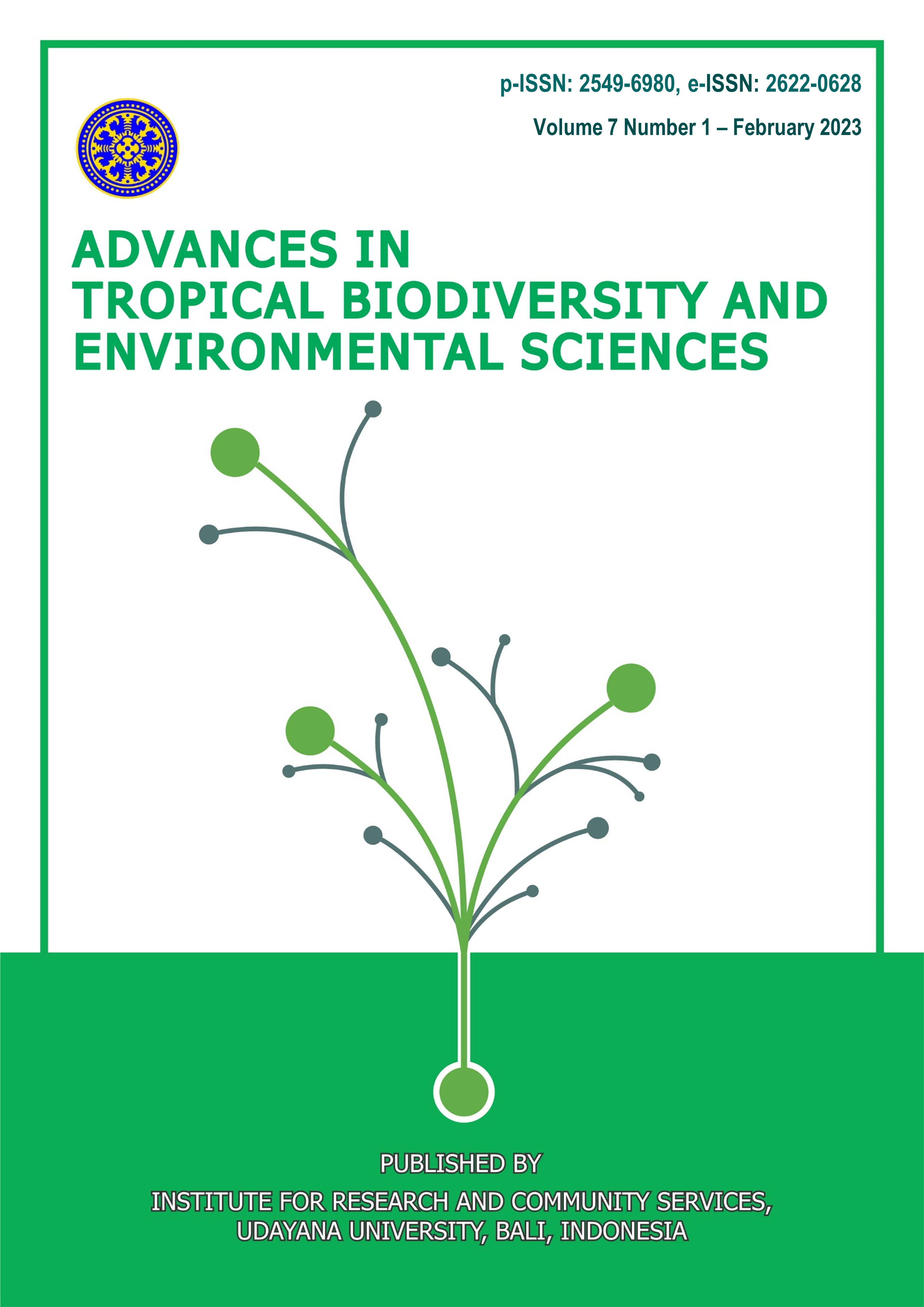Apu Wood (Pistia stratiotes) as Phytoremediation Agent of Screen-printing Wastewater
Abstract
Abstract. The screen-printing process produces wastewater like organic compounds that are difficult to degrade and heavy metals such as chromium, copper, manganese, and lead, which are toxic and can accumulate in the human body through the food chain. Phytoremediation is one method that utilizes plants' ability to reduce organic and inorganic pollutants, including heavy metals. Objective: This study aimed to describe the concentration of screen-printing waste that can be tolerated by apu wood plants and analyze the effectiveness of apu wood as a heavy metal remediator. Technology or Method: The method used in this research is a combination of filtration and phytoremediation using apu wood to reduce heavy metals such as Pb and Cr,6+ and a preliminary test of Pb and Cr6+ contained in the screen-printing wastewater was carried out. Results: Apu wood lives and thrives on screen-printing wastewater, with an average of 34 new individuals' tillers growth within 15 days. The propagation of apu wood in screen-printing wastewater produced total biomass with an average of 145 grams per reactor. The effectiveness of apu wood as a remediator of Pb was 13.65%, and accumulated in the leaves was 0.0911 mg/L. The accumulation of Cr6+ in the leaves was 0.6635 mg/L. The Cr6+ component in the waste during 15 days of treatment did not show a positive effect on metal removal because the higher chromium element oxidation reaction occurred in the wastewater during the research process.
Keywords Apu wood; chromium (VI); filtration; phytoremediation.
Downloads
References
[2] D. Schwantes, A. C. Gonçalves, A. da P. Schiller, J. Manfrin, M. A. Campagnolo, and E. Somavilla, 'Pistia stratiotes in the phytoremediation and post-treatment of domestic sewage', Int J Phytoremediation, vol. 21, no. 7, pp. 714–723, Jun. 2019, doi: 10.1080/15226514.2018.1556591.
[3] A. Setiyono and R. A. Gustaman, ‘Pengendalian Kromium (Cr) yang Terdapat di Limbah Batik dengan Metode Fitoremediasi’, Unnes Journal of Public Health, vol. 6, no. 3, pp. 155–160, 2017, [Online]. Available: http://journal.unnes.ac.id/sju/index.php/ujph
[4] E. Maria and C. Winarti, ‘Removal Limbah Cair Industri Batik dengan Metode Fitoremediasi pada SSF-Wetland Menggunakan Tanaman Obor (Typha Latifolia) dan Tanaman Tasbih (Canna Indica, L.)’, in Prosiding Seminar Nasional dan Call for Papers ‘Pengembangan Sumber Daya Perdesaan dan Kearifan Lokal Berkelanjutan VIII’, 2018, pp. 978–602.
[5] Hernayanti and E. Proklamasiningsih, ‘Fitoremediasi Limbah Cair Batik Menggunakan Kayu Apu (Pistia stratiotes L.) sebagai Upaya untuk Memperbaiki Kualitas Air’, Jurnal Pembangunan Pedesaan, vol. 4, no. 3, Dec. 2004.
[6] B. V. Tangahu, S. R. Sheikh Abdullah, H. Basri, M. Idris, N. Anuar, and M. Mukhlisin, 'A Review on Heavy Metals (As, Pb, and Hg) Uptake by Plants through Phytoremediation', International Journal of Chemical Engineering, vol. 2011, pp. 1–31, 2011, doi: 10.1155/2011/939161.
[7] W. Fadhillah, E. Purba, and D. Elfiati, 'Utilization of Water Hyacinth Plants (Eichornia Crassipes), Jasmine Water (Echinodorus Paleafolius) and Apu Wood (Pistiastratiotes) on Decreasing Level of Liquid Waste Poisonous of Tofu', Journal of Community Service and Research, vol. 1, no. 2, pp. 35–42, 2018, [Online]. Available: http://jurnal.unimed.ac.id/2012/index.php/jcrs/article/view/9333
[8] W. Fadhillah, E. Purba, and D. Elfiati, ‘Utilization of Water Hyacinth Plants (Eichornia crassipes), Jasmine Water (Echinodorus paleafolius) and Apu Wood (Pistia stratiotes) on Decreasing Level of Liquid Waste Poisonous of Tofu’, Journal of Community Research and Service, vol. 1, no. 2, p. 35, Mar. 2018, doi: 10.24114/jcrs.v1i2.9333.
[9] D. G. Raissa and B. V. Tangahu, ‘Fitoremediasi Air yang Tercemar Limbah Laundry dengan Menggunakan Kayu apu (Pistia stratiotes)’, Jurnal Teknik ITS, vol. 6, no. 2, Sep. 2017, doi: 10.12962/j23373539.v6i2.25092.
[10] J. B. Lingkungan, K. Industri, N. Sinulingga, K. Nurtjahja, and A. Karim, 'Phytoremediation of Mercury (Hg) in Water Medium by Warescress (Ipomoea aquatica Forsk.)', BioLink: Jurnal Biologi Lingkungan, Industri, Kesehatan, vol. 2, no. 1, 2015, [Online]. Available: http://ojs.uma.ac.id/index.php/biolink
[11] Rr. A. Chrisafitri and N. Karnaningroem, ‘Pengolahan Air Limbah Pencucian Mobil dengan Reaktor Saringan Pasir Lambat dan Karbon Aktif’, in Prosiding Seminar Nasional Manajemen Teknologi XVI, Jul. 2012, pp. 13–18.
[12] S. Istighfari, D. Dermawan, and N. Eka Mayangsari, ‘Pemanfaatan Kayu Apu (Pistia stratiotes) untuk Menurunkan Kadar BOD, COD, dan Fosfat pada Air Limbah Laundry’, 2018.
[13] Trimanto, ‘Aklimatisasi Tumbuhan Hasil Eksplorasi dan Perbanyakan Tanaman Unit Seleksi dan Pembibitan Kebun Raya Purwodadi’, Seminar Nasional X Pendidikan Biologi FKIP UNS.
[14] W. Zhuang et al., 'Diversity, function and assembly of mangrove root-associated microbial communities at a continuous fine-scale', NPJ Biofilms Microbiomes, vol. 6, no. 1, Dec. 2020, doi: 10.1038/s41522-020-00164-6.
[15] A. Agustina, I. E. Suprihatin, and J. Sibarani, ‘Pengaruh Biofilm terhadap Efektivitas Penurunan BOD, COD, TSS, Minyak dan Lemak dari Limbah Pengolahan Ikan Menggunakan Trickling Filter’, Cakra Kimia (Indonesian E-Journal of Applied Chemistry), vol. 4, no. 2, pp. 137–145, 2016.
[16] R. Quddus, ‘Teknik Pengelolaan Air Bersih dengan Sistem Saringan Pasir Lambat (Dowflow) yang Bersumber dari Sungai Musi’, Jurnal Teknik Sipil dan Lingkungan, vol. 2, no. 4, pp. 669–677, 2014.
[17] T. Murniati and Muljadi, ‘Pengolahan Limbah Batik Cetak Dengan Menggunakan Metodefiltrasi-Elektrolisis Untuk Menentukan Efisiensi Penurunan Parameter COD, BOD, dan Logam Berat (Cr) Setelah Perlakuan Fisika-Kimia’, EKUILIBRIUM, vol. 12, no. 1, pp. 27–36, 2013.
[18] Z. Mekhelf, A. Subhi, and R. Hamied, ‘Removal of Iron From Produced Water Using Silica Adsorbent Material’, Engineering and Technology Journal, vol. 38, no. 8, pp. 1154–1159, Aug. 2020, doi: 10.30684/etj.v38i8A.1125.
[19] M. Assiddieq, S. Darmayani, and W. Kudonowarso, 'The Use of Silica Sand, Zeolite and Active Charcoal to Reduce BOD, COD, and TSS of Laundry Wastewater as a Biology Learning Resources', JPBI (Jurnal Pendidikan Biologi Indonesia), vol. 3, no. 3, pp. 202–207, Nov. 2017, doi: 10.22219/jpbi.v3i3.4864.
[20] M. H. Poernomo, M. Razif, and A. Mansur, ‘Pengolahan Air Limbah Dometsik dengan Metode Kombinasi Filtrasi dan Fitoremediasi (Studi Kasus di Kelurahan Margorejo Surabaya)’, Seminar Nasional Sains dan Teknologi Terapan VIII, pp. 177–184, 2020.
[21] Suherman, S. Rahmawati, I. Said, Nurbaya, S. Armiyanti, and N. Thamrin, 'The use of water spinach plants (Ipomoea aquatica Forsk.) for phytoremediation of hospital waste', J Phys Conf Ser, vol. 2126, no. 1, p. 012026, Nov. 2021, doi: 10.1088/1742-6596/2126/1/012026.
[22] PSATS, 'Wastewater Treatment Plant Operator Certification Training', Pennsylvania, 2020.
[23] L. E. Erickson and V. Pidlisnyuk, Phytotechnology with Biomass Production. Boca Raton: CRC Press, 2021. doi: 10.1201/9781003082613.
[24] G. M. Evans and J. C. Furlong, 'Environmental Biotechnology Theory and Application', 2003.
[25] I. K. Semita, I. P. Sujana, and I. M. Suryana, ‘Pengaruh Pemberian Biochar terhadap Tanaman Sawi Hijau (Brassica Juncea L.) pada Lahan yang Tercemar Limbah Cair di Subak Cuculan Desa Kepaon’, AGRIMETA : Jurnal Pertanian Berbasis Keseimbangan Ekosistem., vol. 7, no. 14, 2017.
[26] J. Ris Kim, Z. Chaidir, Q. Hasanah, and R. Zein, ‘Penyerapan Ion Logam Cr(III) dan Cr(VI) dalam Larutan Menggunakan Kulit Buah Jengkol (Pithecellobium jiringa (Jack) Prain.)’, vol. 8, no. 2, 2015.
[27] S. Simatupang, ‘Pengkajian Subsitusi Aquades dengan Sumber Air Lainnya pada Per-banyakan Mikro Pisang Barangan dan Stroberi’, J. Hort, vol. 16, no. 4, pp. 299–306, 2006.
[28] G. M. Evans and J. C. Furlong, Environmental Biotechnology: Theory and Application, 1st ed., vol. 1. Durham: John Wiley & Sons, LTD, 2003.
[29] R. Y. Surampalli, P. Champagne, S. K. Ong, R. D. Tyagi, and I. M. C. Lo, Remediation Technologies for Soils and Groundwater, vol. 1. Reston, VA: American Society of Civil Engineers, 2007.
[30] S. Kurniawati and Nur, ‘Risiko Kesehatan Lingkungan Pencemaran Logam Berat Kromium Heksavalen (Cr VI) pada Ikan Nila (Oreochromis niloticus) di Aliran Sungai Garang Kota Semarang’, Higiene, vol. 3, no. 3, pp. 152–160, 2017.
[31] J. Chen, Q. Nie, Y. Zhang, J. Hu, and L. Qing, 'Eco-physiological characteristics of Pistia stratiotes and its removal of pollutants from livestock wastewater', Water Science and Technology, vol. 69, no. 12, pp. 2510–2518, Jun. 2014, doi: 10.2166/wst.2014.176.
[32] R. Rahadian, E. Sutrisno, and S. Sumiyati, ‘Efisiensi Penurunan COD dan TSS dengan Fitoremediasi Menggunakan Tanaman Kayu Apu (Pistia stratiotes l.) Studi Kasus: Limbah Laundry’, Jurnal Teknik Lingkungan, vol. 6, no. 3, 2017, [Online]. Available: http://ejournal-s1.undip.ac.id/index.php/tlingkungan
[33] S. Z. Ahammad, D. W. Graham, and J. Dolfing, 'Wastewater Treatment: Biological', in Managing Water Resources and Hydrological Systems, CRC Press, 2020, pp. 561–576. doi: 10.1201/9781003045045-61.













